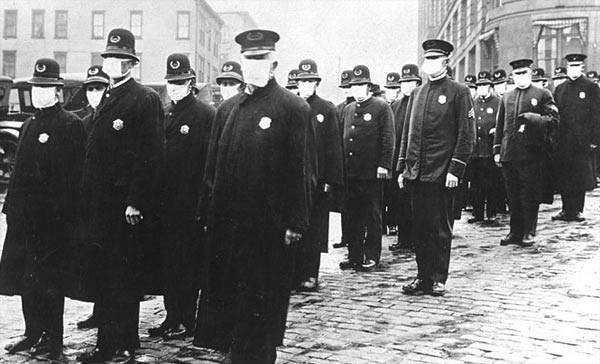Some went on in this manner for months before dying. A very few survived and regained consciousness but not their former liveliness. They existed in a state of profound apathy, "like extinct volcanoes," in the words of one doctor. In ten years the disease killed some five million people and then quietly went away. It didn't get much lasting attention because in the meantime an even worse epidemic——indeed, the worst in history——swept across the world.
有的几个月处于那种状态,然后死去。极少的人幸免于难,恢复了知觉,但不再像以往那样充满活力。他们处于没清打采的状态,用一位医生的话来说,“犹如一座座死火山”。这种病在10年时间里致使大约500万人死亡,然后悄地消失了。它没有引起太久的重视,因为同时另一种更可怕的流行病——实际上是历史上最可怕的流行病——正在世界各地传播。
It is sometimes called the Great Swine Flu epidemic and sometimes the Great Spanish Flu epidemic, but in either case it was ferocious. World War I killed twenty-one million people in four years; swine flu did the same in its first four months. Almost 80 percent of American casualties in the First World War came not from enemy fire, but from flu. In some units the mortality rate was as high as 80 percent.
那种病有时候被称之为“猪大流感”,有时候被称之为“西班牙大流感”,但无论如何是很凶猛的。第一次世界大战在4年内使2100万人丧生;猪大流感在头4个月里就造成了同样的结果。第一次世界大战期间,在美军的伤亡人数中,差不多80%不是敌人的炮火而是流感造成的,有的部队死亡率高达80%。

Swine flu arose as a normal, nonlethal flu in the spring of 1918, but somehow over the following months—no one knows how or where—it mutated into something more severe. A fifth of victims suffered only mild symptoms, but the rest became gravely ill and often died. Some succumbed within hours; others held on for a few days.
1918年春天,猪大流感以一种不致命的普通流感的症状出现然而在随后的几个月里,不知怎的——谁也不知道以什么方式,在什么地方——那种疾病变得严重起来。五分之一的病人只有很轻的症状,但其余的病得很重,许多人死亡。有的在几个小时里就倒下了;有的只坚持了几天。
In the United States, the first deaths were recorded among sailors in Boston in late August 1918, but the epidemic quickly spread to all parts of the country. Schools closed, public entertainments were shut down, people everywhere wore masks. It did little good.
擗记载,美国的第一批死者是波士顿的海员,那是在1918年8月来。流行病很快就传播到全国各地。学校停课,公共娱乐场所关门,人们都戴着口罩。这么做没有起多大作用。













